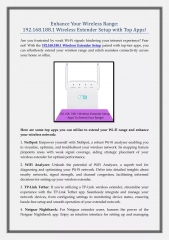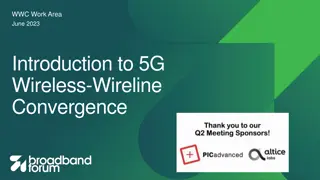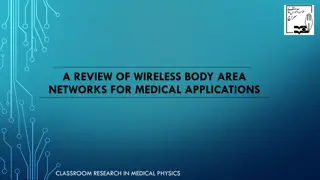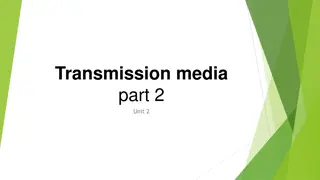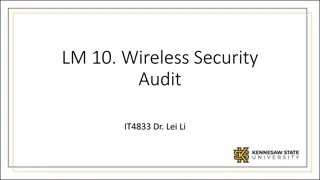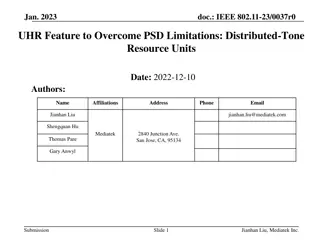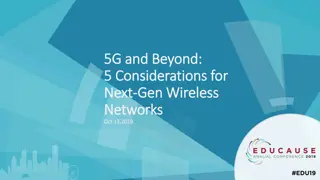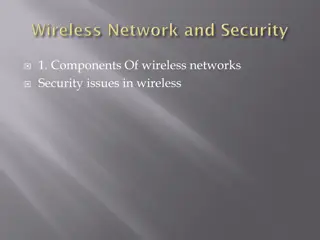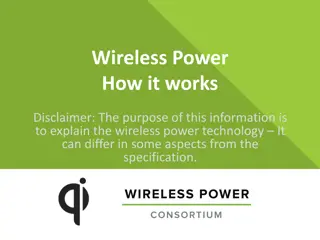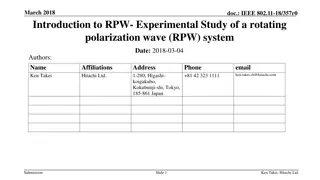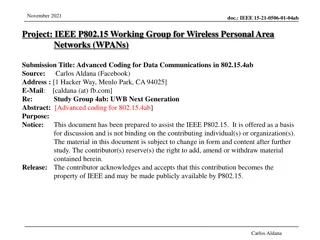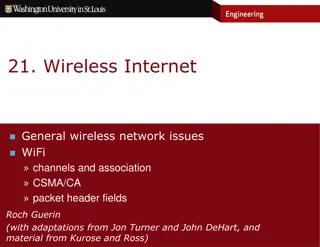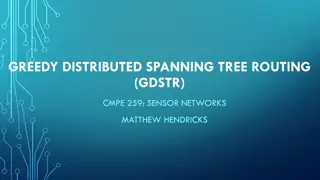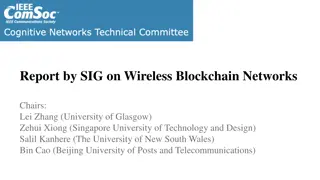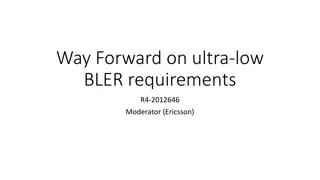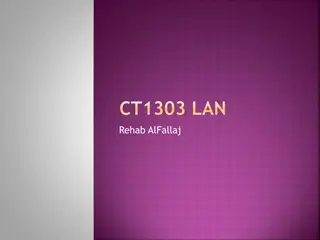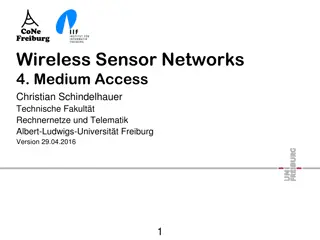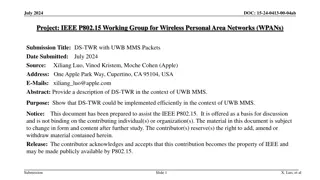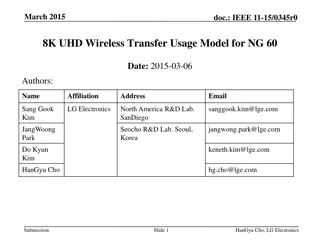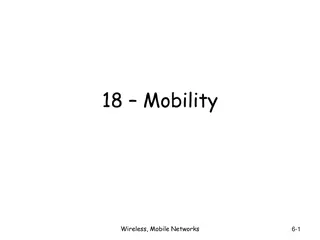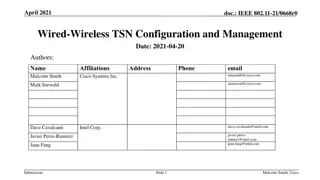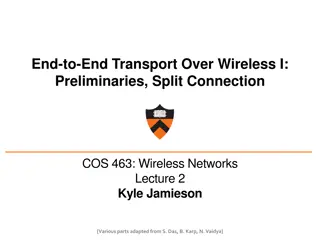Enhance Your Wireless Range: 192.168.188.1 Wireless Extender Setup with Top Apps
Are you tired of weak Wi-Fi signals limiting your internet access? Fear not! With the 192.168.188.1 Wireless Extender Setup and some top-notch apps, you can extend your wireless range and enjoy seamless connectivity throughout your home or office.\n\nfor more info: https:\/\/1921681881.com\/192-168-
6 views • 2 slides
Scrolls:Rolling Flexible Surfaces for Wideband Wireless
Revolutionizing wireless communication, the Scrolls project introduces rolling flexible surfaces for wideband wireless applications. With the expectation of 30 billion wireless devices by 2025, the project emphasizes standards and frequencies such as Cellular, Wi-Fi, and IoT. By offering a standard-
2 views • 19 slides
Understanding Wireless Communication Networks by Dr. K. Gopi at SITAMS
Wireless Communication Networks (WCN) is a fundamental aspect of modern telecommunication, allowing information transfer without physical connections. Dr. K. Gopi, an Associate Professor at the Department of ECE at SITAMS, introduces concepts like multiple access techniques, traffic routing, and the
1 views • 13 slides
Evolution of Wireless-Wireline Convergence in 5G Networks
The convergence of wireless and wireline networks in the context of 5G brings about significant changes and improvements. This evolution involves the integration of 5G core networks, new access network functions, enhanced interfaces, and the introduction of new devices like 5G residential gateways.
7 views • 25 slides
A Review of Wireless Body Area Networks for Medical Applications
Recent advancements in MEMS technology, integrated circuits, and wireless communication have enabled the development of Wireless Body Area Networks (WBANs) for ambulatory health monitoring. This paper discusses the infrastructure, in-body antenna design, low-power MAC protocol, and various applicati
1 views • 23 slides
Understanding Artificial Neural Networks From Scratch
Learn how to build artificial neural networks from scratch, focusing on multi-level feedforward networks like multi-level perceptrons. Discover how neural networks function, including training large networks in parallel and distributed systems, and grasp concepts such as learning non-linear function
1 views • 33 slides
Challenges and Solutions in Wireless Ad Hoc Networks
This content delves into the complexities of wireless ad hoc networks, focusing on issues such as medium access control, hidden node problems, and location-dependent carrier sensing. It discusses design challenges, including bandwidth efficiency and quality of service support, as well as practical s
0 views • 32 slides
Understanding Different Types of Wireless Transmission Media
Wireless transmission encompasses various forms of unguided media, including radio, microwave, and infrared waves. Each type serves unique communication purposes based on their frequency ranges, wavelengths, and propagation characteristics. Wireless signals, whether through radio waves with extensiv
0 views • 6 slides
Rate Optimization in Wideband RIS-assisted Wireless Systems
This research focuses on rate optimization in wideband RIS-assisted wireless systems, specifically investigating MIMO RIS-assisted systems in sub-6 GHz mmWave settings. Pathloss and blockage modeling, along with LOS vs. spectral efficiency and RIS-UE distance vs. spectral efficiency analyses, are ke
0 views • 4 slides
Spectrum Sensing for Enhanced Channel Access in Wireless Networks
This document presents a proposal for Spectrum Sensing Based Deferral (SSBD) to improve channel access in wireless networks. SSBD incorporates spectrum sensing with transmission deferral in a time-bound manner to enhance performance, reliability, and latency control. The proposed solution safeguards
1 views • 11 slides
Understanding Wireless Wide Area Networks (WWAN) and Cellular Network Principles
Wireless Wide Area Networks (WWAN) utilize cellular network technology like GSM to facilitate seamless communication for mobile users by creating cells in a geographic service area. Cellular networks are structured with backbone networks, base stations, and mobile stations, allowing for growth and c
2 views • 17 slides
Understanding Wireless Security Audits and Best Practices
Explore the world of security audits with a focus on wireless networks. Learn about the types of security audits, best practices, and the steps involved. Discover the importance of systematic evaluations, identifying vulnerabilities, establishing baselines, and compliance considerations. Dive into t
0 views • 14 slides
Wireless TSN in 802.11: New Requirements and Integration with 802.1
This document discusses the extension of TSN capabilities from wired to wireless networks, focusing on potential enhancements for 802.11be and integration with Ethernet-based TSN standards. It covers topics such as time-sensitive applications, TSN toolbox overview, status of TSN capabilities support
4 views • 12 slides
Understanding Computer Communication Networks at Anjuman College
This course focuses on computer communication networks at Anjuman College of Engineering and Technology in Tirupati, covering topics such as basic concepts, network layers, IP addressing, hardware aspects, LAN standards, security, and administration. Students will learn about theoretical and practic
0 views • 72 slides
Introduction to Neural Networks in IBM SPSS Modeler 14.2
This presentation provides an introduction to neural networks in IBM SPSS Modeler 14.2. It covers the concepts of directed data mining using neural networks, the structure of neural networks, terms associated with neural networks, and the process of inputs and outputs in neural network models. The d
0 views • 18 slides
Enhancing Wireless Spectrum Efficiency with Distributed-Tone Resource Units in IEEE 802.11
In the document "Jan 2023.doc: IEEE 802.11-23/0037r0," the focus is on leveraging Distributed-Tone Resource Units (dRU) to overcome Power Spectral Density (PSD) limitations in wireless communication. By distributing tones over a wide bandwidth, dRU allows for higher transmit power, enabling enhanced
0 views • 9 slides
Exploring Considerations for Next-Gen Wireless Networks
Emerging technologies and user behavior are driving the demand for advancements in wireless networks, particularly in the context of 5G and beyond. This presentation delves into key considerations such as the role of universities, drivers of 5G development, near-term technologies, infrastructure opt
0 views • 25 slides
Tamper-Evident Pairing (TEP) Protocol for Secure Wireless Pairing Without Passwords
This article discusses the challenges of traditional secure wireless pairing methods that rely on password validation and proposes the Tamper-Evident Pairing (TEP) protocol as a secure in-band solution to protect against Man-in-the-Middle (MITM) attacks. TEP eliminates the need for out-of-band chann
1 views • 40 slides
Effective Communication Strategies in Business Environments
Explore the various aspects of communication processes within organizations, including sender-receiver dynamics, communication channels, small group networks, upward and downward communication methods, business communication tools, information richness of channels, email and voice mail etiquette, an
0 views • 21 slides
Enhancing Throughput in Multi-Hop Wireless Networks Using Reconfigurable Antennas
In this study presented at IEEE SECON 2018, the authors investigate the throughput limits of multi-hop wireless networks employing reconfigurable antennas (RAs). Challenges such as unreliable links, interference, and large overhead are addressed, with existing approaches at both the link/network lay
0 views • 29 slides
Wireless LANs: Components and Security Issues
Wireless LANs use radio waves to connect users within a building or campus. This technology overview covers IEEE 802.11 standards, migration to WLANs, and connection to wired LANs through access points. Understanding the specialized protocols, security considerations, and performance differences is
0 views • 29 slides
Understanding Wireless Power Technology
Explore the functionality of wireless power technology, focusing on applications like battery charging for mobile devices. Learn about the system components, power conversion processes, control mechanisms, and communication between transmitters and receivers. Discover the principles behind wireless
0 views • 16 slides
Exploring Wireless Technologies and Mobile Commerce
Delve into the realm of wireless technologies, mobile computing, and mobile commerce with a focus on the advantages and disadvantages of wireless transmission media, business applications of short-range to long-range networks, m-commerce benefits for businesses, technologies in pervasive computing,
0 views • 36 slides
Experimental Study of Rotating Polarization Wave (RPW) System in Wireless Communication
A wireless system controlling polarization for improved communication quality was tested successfully in various environments, enhancing quality especially in cluttered spaces without line-of-sight paths. By manipulating polarization, data transfer reliability and effectiveness were enhanced, overco
0 views • 14 slides
Advanced Coding Techniques for Wireless Personal Area Networks - IEEE 802.15.4ab
This document discusses advanced coding techniques proposed for IEEE 802.15.4ab to enhance data communication in wireless personal area networks. The focus is on interference mitigation, coexistence improvement, link budget enhancement, additional channels, and operating frequencies for improved rel
0 views • 22 slides
Wireless Network Essentials and Classification
Wireless networks play a vital role in our modern world, with mobile devices outnumbering wired connections. This overview covers wireless network fundamentals, including elements, characteristics of wireless links, ad hoc operations, and network classifications like mesh networks and MANET.
0 views • 45 slides
Understanding Greedy Distributed Spanning Tree Routing in Wireless Sensor Networks
Wireless sensor networks play a critical role in various applications, and the Greedy Distributed Spanning Tree Routing (GDSTR) protocol, developed by Matthew Hendricks, offers an efficient routing approach. This protocol addresses challenges such as scalability, dynamic topologies, and sensor node
0 views • 34 slides
Report on Wireless Blockchain Networks by SIG Chairs
A detailed report by SIG Chairs Lei Zhang, Zehui Xiong, Salil Kanhere, and Bin Cao focusing on using blockchain for communication and optimizing blockchain performance in the context of 5G/6G networks. The report outlines the scope, team members, and upcoming activities related to Wireless Blockchai
0 views • 6 slides
Understanding Overlay Networks and Distributed Hash Tables
Overlay networks are logical networks built on top of lower-layer networks, allowing for efficient data lookup and reliable communication. They come in unstructured and structured forms, with examples like Gnutella and BitTorrent. Distributed Hash Tables (DHTs) are used in real-world applications li
0 views • 45 slides
Way Forward on Ultra-Low BLER Requirements in Wireless Communication
Explore the agreements and discussions around ultra-low BLER (Block Error Rate) requirements for URLLC (Ultra-Reliable Low Latency Communication) in wireless communication systems. Gain insights into the test methodologies, decision co-ordinates, applicability rules, and open issues related to CQI (
0 views • 9 slides
Understanding Wireless Networks: Types and Applications
Wireless networks utilize wireless data connections to connect network nodes and share resources. They include Wireless Personal Area Networks (WPAN), Wireless LAN, Wireless WAN, Wireless Broadband, and Wireless Cellular. Each type has specific characteristics and applications, such as linking perso
0 views • 29 slides
Wireless Sensor Networks: Medium Access Protocols Overview
This collection of images presents key concepts in wireless sensor networks, focusing on medium access protocols, the ISO/OSI reference model, types of conflict resolution, contention-free protocols, Bitmap protocol, ALOHA algorithm, and its analysis and efficiency. Various protocols and algorithms
0 views • 83 slides
Efficient Implementation of DS-TWR with UWB MMS for Wireless Personal Area Networks
Description of DS-TWR in the context of UWB MMS, emphasizing its efficient implementation for Wireless Personal Area Networks. The document presents the necessity of DS-TWR in Mixed MMS for Ranging Integrity and summarizes its application with Mixed MMS in various scenarios involving packet transmis
0 views • 14 slides
Wireless Office Docking Model for Multiple Devices
This document outlines a usage model for office docking involving wireless connections between mobile devices and various peripheral devices such as monitors, hard drives, printers, and more. It describes scenarios for single and multiple devices in both home and office settings, emphasizing the nee
0 views • 5 slides
Evolution of 8K UHD Wireless Transfer Usage Model for Next Generation Displays
This IEEE document discusses the evolution of high-resolution displays and services, reviews wired interface solutions, and proposes a wireless transfer usage model for 8K UHD displays. It covers the advancements in display technology, including commercial 4K and 8K UHD offerings, broadcast services
0 views • 11 slides
Overview of External Wireless Communication System on International Space Station (ISS)
This presentation covers the overview and experience of implementing an external 802.11n wireless communication system on the International Space Station (ISS). It discusses the existing wireless system, committed users, system architecture, and future challenges. The system provides high data rate
0 views • 18 slides
Understanding Mobility in Wireless and Mobile Networks
Explore the vocabulary and approaches related to mobility in wireless and mobile networks. Understand concepts such as home network, home agent, permanent address, visited network, care-of-address, and more. Learn about different mobility approaches and the registration process in these networks.
0 views • 17 slides
Challenges and Solutions in Wired-Wireless TSN Configuration
This document discusses the challenges faced in configuring and managing wired-wireless TSN domains, focusing on the unique aspects of wireless networks such as fading, variable delays, and shared medium access. It presents models for physical and logical integration of wired and wireless TSN, empha
0 views • 13 slides
Understanding Layering in Wireless Networks
This content delves into the concept of layering in wireless networks, highlighting the motivation behind layering, the Internet's approach to avoiding reimplementation for each underlying medium, the role of intermediate layers in providing abstractions, properties of network layers, and the functi
0 views • 53 slides
Understanding Network Analysis: Whole Networks vs. Ego Networks
Explore the differences between Whole Networks and Ego Networks in social network analysis. Whole Networks provide comprehensive information about all nodes and links, enabling the computation of network-level statistics. On the other hand, Ego Networks focus on a sample of nodes, limiting the abili
0 views • 31 slides
